 AbiuroOne way to increase ethanol production from the same hectare of sugarcane is by creating new strains and improving the yield performance of Saccharomyces cerevisiae, the yeast responsible for transforming sugar into alcohol during fermentation. Research conducted by Professor Anderson Cunha at the Federal University of São Carlos (UFSCar) is focusing on six yeast strains; two are thermotolerant, that is, resistant to the high temperatures inside fermentation tanks — an important feature for tropical regions — and four strains are resistant to ethanol itself, which becomes toxic to these strains during the process.
AbiuroOne way to increase ethanol production from the same hectare of sugarcane is by creating new strains and improving the yield performance of Saccharomyces cerevisiae, the yeast responsible for transforming sugar into alcohol during fermentation. Research conducted by Professor Anderson Cunha at the Federal University of São Carlos (UFSCar) is focusing on six yeast strains; two are thermotolerant, that is, resistant to the high temperatures inside fermentation tanks — an important feature for tropical regions — and four strains are resistant to ethanol itself, which becomes toxic to these strains during the process.
“We focus on finding genes that are heat and ethanol resistant, and on transferring them to strains that are well adapted to the industrial process,” says Cunha, who coordinates a project funded by FAPESP under the Application-oriented Research Program in the Partnership for Technological Innovation (PITE), in partnership with ETH Bioenergia. Or if they prove suitable and demonstrate a high level of efficiency in the fermentation process, even these isolated yeasts are used. Since the process is open, the tanks obtain yeast from the air and the sugarcane itself and invade the fermentation process.
The research that led to the PITE project began in 2009, when Cunha joined Usina São Luís, located in Ourinhos, São Paulo State, to monitor the ethanol production process during the harvest. Since then, yeast samples have been taken from the fermentation tanks every 15 days during the harvest for later selection in the laboratory. “We choose yeast that is morphologically different from industrial yeast,” says Cunha. Then the yeast is tested for resistance to ethanol and temperature. As the temperature in the process has to be around 30°C, for purposes of consistency, a cooling system is needed in the tanks, which represents an additional cost. “So if we can isolate strains that are resistant at 40°C, the tanks do not need to be cooled.”
Besides the selection and tests conducted to find strains of interest, fermentation tests are also conducted. As a result of this collection at the plant, a yeast bank was created, which currently has about 400 strains with distinct fermentation characteristics, of which six were chosen as capable of fermentation at high temperatures and at high concentrations of ethanol. The others are being tested for other purposes.
In addition to improving the steadily increasing production of traditional Saccharomyces cerevisiae, other lines of research are looking into other microorganisms that may assist in this process and increase ethanol production. Professor Francisco Maugeri Filho of the University of Campinas (Unicamp) is coordinating studies of wild yeast isolated from Brazilian biomes — the Amazon forest, Atlantic Forest, Cerrado and Pantanal — in a project funded by FAPESP, whose results are very promising. “We were able to isolate more than 300 microorganisms during this project,” says Mauger.
“Our initial goal was to isolate only yeast, but through molecular identification we later found that some microorganisms were polymorphic fungi,” he says. During the identification process, they found true yeast — unicellular fungi — and polymorphic fungi that in liquid media resemble yeast, such as Acremonium strictum, are capable of producing cellulolytic enzymes, that is, enzymes that hydrolyze cellulose, an interesting attribute for second-generation ethanol. After the genes that produce these enzymes were identified, they were first cloned into the bacterium Escherichia coli, a microorganism-model, and then into the yeast Saccharomyces cerevisiae, so that the yeast could degrade the cellulose into glucose, and then convert it into fuel.
The research was part of a doctoral study undertaken by Rosana Goldbeck at Unicamp’s School of Food Engineering (FEA); Maugeri, who oversees bioprocess engineering research, served as her advisor, and Professor Gonçalo Amarante Guimarães Pereira of the university’s Institute of Biology was co-advisor. “The results were very interesting, but there is still much work to do if they are to be used in industrial processes,” says Maugeri. The next stage involves tests with industrial yeast, such as Pedra and Pedra 2, which are known to be highly productive in ethanol fermentation.
Projects
1. Study of genetics and alcoholgenic potential of wild yeasts isolated from several Brazilian regions aiming at the production of bioethanol (nº 2009/52198-3); Grant Mechanism Regular Line of Research Project Award; Coord. Francisco Maugeri Filho/Unicamp; Investment R$ 184,029.82 (FAPESP).
2. Genomics and transcriptomic analysis of thermo- and ethanol-resistant strains of Saccharomyces cerevisiae isolated during the process of ethanol production – construction of biological platforms for industrial use (nº 2012/50064-2); Grant Mechanism Application-oriented Research Program in the Partnership for Technological Innovation (PITE); Coord. Anderson Ferreira da Cunha/UFSCAR; Investment R$ 330,557.02 (FAPESP and ETH Bioenergia).

